Organizational Change: Assessing Socio-Technical & Lean Production
VerifiedAdded on 2023/06/15
|9
|2682
|499
Essay
AI Summary
This essay critically evaluates the usefulness of socio-technical systems and lean production as change tools for both manufacturing and service companies. It argues that while both tools have their merits, socio-technical systems are particularly well-suited for the service industry, while lean production is more effective in manufacturing. The essay explores the characteristics of each industry, highlighting key differences such as tangibility, inventory management, and the importance of specific skill sets. It details the principles and benefits of lean production in manufacturing, including global orientation, innovation, and effective supply chain management, while also acknowledging its limitations in the service sector. Furthermore, the essay discusses the socio-technical system approach, emphasizing its focus on blending technical and social systems to create value for stakeholders, and its suitability for addressing the unique challenges of the service industry, such as intangibility, inseparability, perishability, and variability. The analysis underscores the importance of supplier partnerships, customer relations, and internal systems in driving improved performance through the implementation of these change tools. Desklib provides access to similar solved assignments for students.
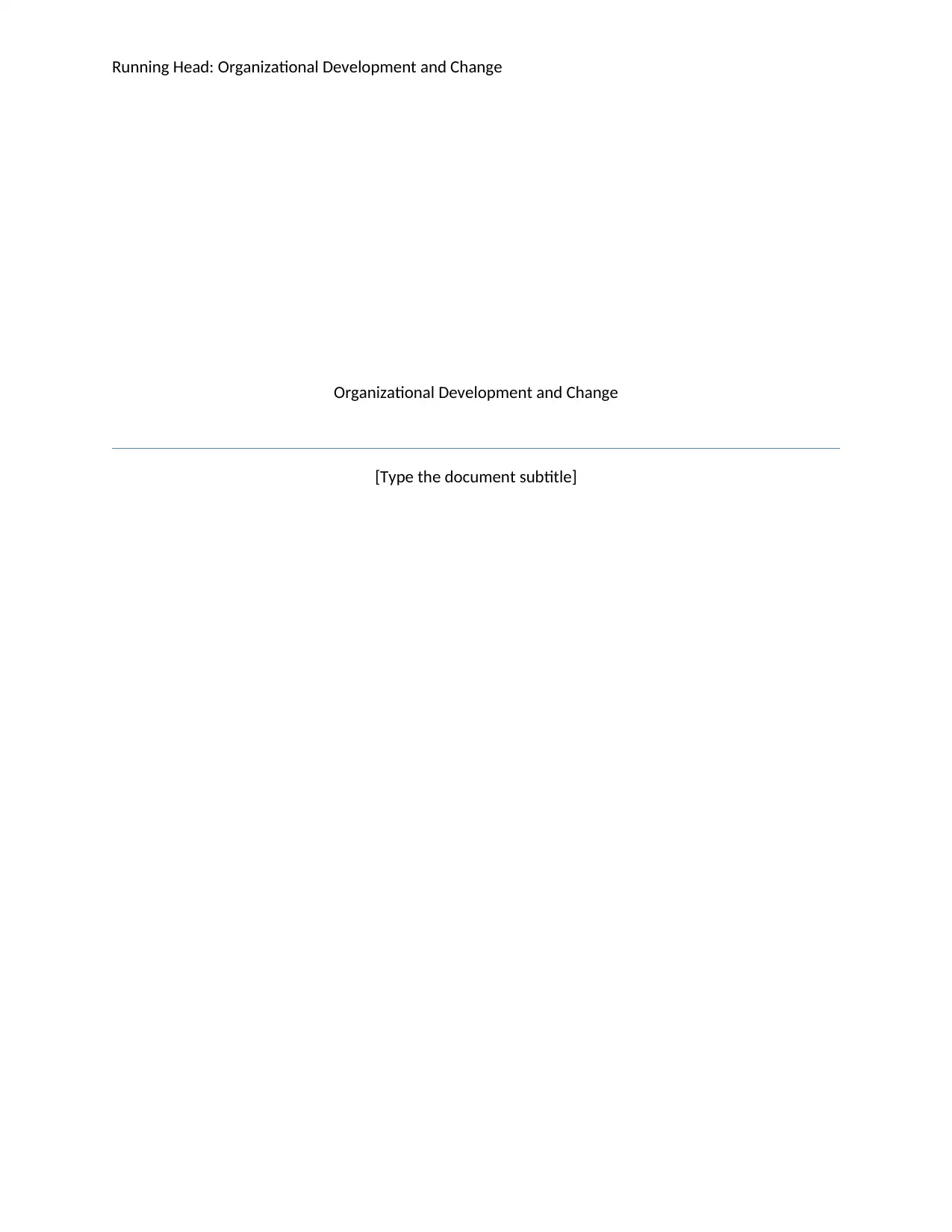
Running Head: Organizational Development and Change
Organizational Development and Change
[Type the document subtitle]
Organizational Development and Change
[Type the document subtitle]
Paraphrase This Document
Need a fresh take? Get an instant paraphrase of this document with our AI Paraphraser
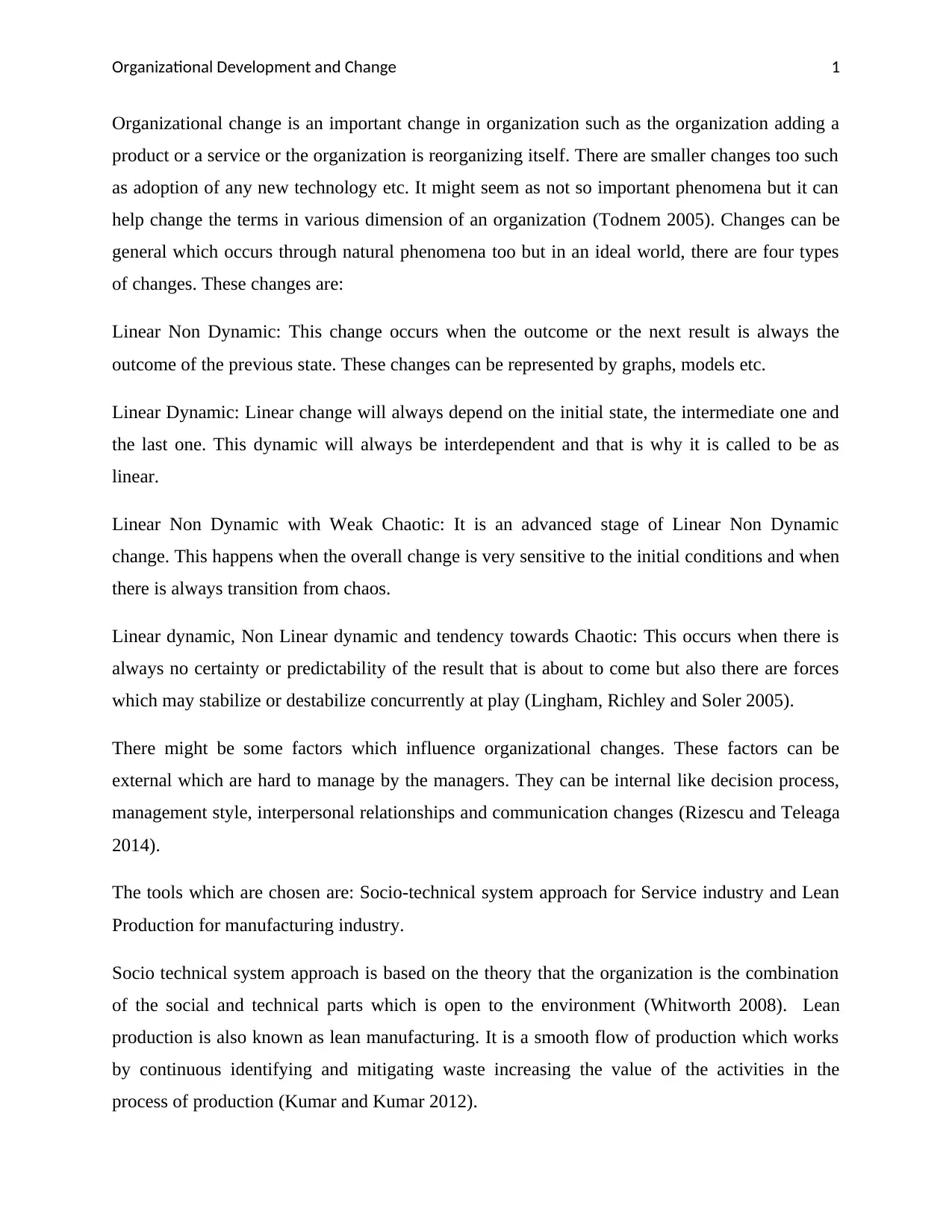
Organizational Development and Change
Organizational change is an important change in organization such as the organization adding a
product or a service or the organization is reorganizing itself. There are smaller changes too such
as adoption of any new technology etc. It might seem as not so important phenomena but it can
help change the terms in various dimension of an organization (Todnem 2005). Changes can be
general which occurs through natural phenomena too but in an ideal world, there are four types
of changes. These changes are:
Linear Non Dynamic: This change occurs when the outcome or the next result is always the
outcome of the previous state. These changes can be represented by graphs, models etc.
Linear Dynamic: Linear change will always depend on the initial state, the intermediate one and
the last one. This dynamic will always be interdependent and that is why it is called to be as
linear.
Linear Non Dynamic with Weak Chaotic: It is an advanced stage of Linear Non Dynamic
change. This happens when the overall change is very sensitive to the initial conditions and when
there is always transition from chaos.
Linear dynamic, Non Linear dynamic and tendency towards Chaotic: This occurs when there is
always no certainty or predictability of the result that is about to come but also there are forces
which may stabilize or destabilize concurrently at play (Lingham, Richley and Soler 2005).
There might be some factors which influence organizational changes. These factors can be
external which are hard to manage by the managers. They can be internal like decision process,
management style, interpersonal relationships and communication changes (Rizescu and Teleaga
2014).
The tools which are chosen are: Socio-technical system approach for Service industry and Lean
Production for manufacturing industry.
Socio technical system approach is based on the theory that the organization is the combination
of the social and technical parts which is open to the environment (Whitworth 2008). Lean
production is also known as lean manufacturing. It is a smooth flow of production which works
by continuous identifying and mitigating waste increasing the value of the activities in the
process of production (Kumar and Kumar 2012).
1
Organizational change is an important change in organization such as the organization adding a
product or a service or the organization is reorganizing itself. There are smaller changes too such
as adoption of any new technology etc. It might seem as not so important phenomena but it can
help change the terms in various dimension of an organization (Todnem 2005). Changes can be
general which occurs through natural phenomena too but in an ideal world, there are four types
of changes. These changes are:
Linear Non Dynamic: This change occurs when the outcome or the next result is always the
outcome of the previous state. These changes can be represented by graphs, models etc.
Linear Dynamic: Linear change will always depend on the initial state, the intermediate one and
the last one. This dynamic will always be interdependent and that is why it is called to be as
linear.
Linear Non Dynamic with Weak Chaotic: It is an advanced stage of Linear Non Dynamic
change. This happens when the overall change is very sensitive to the initial conditions and when
there is always transition from chaos.
Linear dynamic, Non Linear dynamic and tendency towards Chaotic: This occurs when there is
always no certainty or predictability of the result that is about to come but also there are forces
which may stabilize or destabilize concurrently at play (Lingham, Richley and Soler 2005).
There might be some factors which influence organizational changes. These factors can be
external which are hard to manage by the managers. They can be internal like decision process,
management style, interpersonal relationships and communication changes (Rizescu and Teleaga
2014).
The tools which are chosen are: Socio-technical system approach for Service industry and Lean
Production for manufacturing industry.
Socio technical system approach is based on the theory that the organization is the combination
of the social and technical parts which is open to the environment (Whitworth 2008). Lean
production is also known as lean manufacturing. It is a smooth flow of production which works
by continuous identifying and mitigating waste increasing the value of the activities in the
process of production (Kumar and Kumar 2012).
1

Organizational Development and Change
This essay focuses on the argument that Socio technical system and lean production tool are both
useful for service industry and manufacture industry respectively but only Socio technical system
is useful for service industry.
This essay mainly focuses on the characteristics of the companies which manufacture goods and
those companies which provide services. Manufacturing industry is a business which converts
raw materials into finished goods with the help of using labor, machines, and tools. It includes
production of chemicals, machines, textiles and foods (Kocic 2017). Service industry is one
which creates services instead of providing tangible goods. Service industries include banking,
wholesale and communications etc.
Characteristics of Manufacturing Industry are Global Orientation, new innovations, developing
best assets, effective supply chain etc. The characteristics of Service industry are Intangibility,
Perishability, inseparability and variability. All these are discussed in this essay in details.
Similarities are: Irrespective of the industry, process is something everybody has to follow a
certain business. Use of technology is always there irrespective of the industry. It is always
required to have good quality of goods and services. The productivity should always be high.
Customer satisfaction is on the priority in every industry.
Differences are: Tangibility is the key difference in manufacture and service industry.
Manufacturing industries hold an inventory unlike service industry. Service industry keeps on
producing services irrespective of the customers needing it or not but it is not the case in
manufacturing industry. Service industry needs and hires people with specific knowledge and
skill set. Manufacturing industry can easily automate its production to reduce labor (Zhou, PArk
and Yi 2009).
Manufacture Industry
Lean production was earlier streamlined with manufacturing industry and then it was started to
be known as lean philosophy. But later it moved to the other industries as well such as service
industry, trade and public sector (Sharma 2013). Even after the movement of lean production in
service industry, it is not seem as much in this industry and is important for manufacture industry
2
This essay focuses on the argument that Socio technical system and lean production tool are both
useful for service industry and manufacture industry respectively but only Socio technical system
is useful for service industry.
This essay mainly focuses on the characteristics of the companies which manufacture goods and
those companies which provide services. Manufacturing industry is a business which converts
raw materials into finished goods with the help of using labor, machines, and tools. It includes
production of chemicals, machines, textiles and foods (Kocic 2017). Service industry is one
which creates services instead of providing tangible goods. Service industries include banking,
wholesale and communications etc.
Characteristics of Manufacturing Industry are Global Orientation, new innovations, developing
best assets, effective supply chain etc. The characteristics of Service industry are Intangibility,
Perishability, inseparability and variability. All these are discussed in this essay in details.
Similarities are: Irrespective of the industry, process is something everybody has to follow a
certain business. Use of technology is always there irrespective of the industry. It is always
required to have good quality of goods and services. The productivity should always be high.
Customer satisfaction is on the priority in every industry.
Differences are: Tangibility is the key difference in manufacture and service industry.
Manufacturing industries hold an inventory unlike service industry. Service industry keeps on
producing services irrespective of the customers needing it or not but it is not the case in
manufacturing industry. Service industry needs and hires people with specific knowledge and
skill set. Manufacturing industry can easily automate its production to reduce labor (Zhou, PArk
and Yi 2009).
Manufacture Industry
Lean production was earlier streamlined with manufacturing industry and then it was started to
be known as lean philosophy. But later it moved to the other industries as well such as service
industry, trade and public sector (Sharma 2013). Even after the movement of lean production in
service industry, it is not seem as much in this industry and is important for manufacture industry
2
⊘ This is a preview!⊘
Do you want full access?
Subscribe today to unlock all pages.

Trusted by 1+ million students worldwide
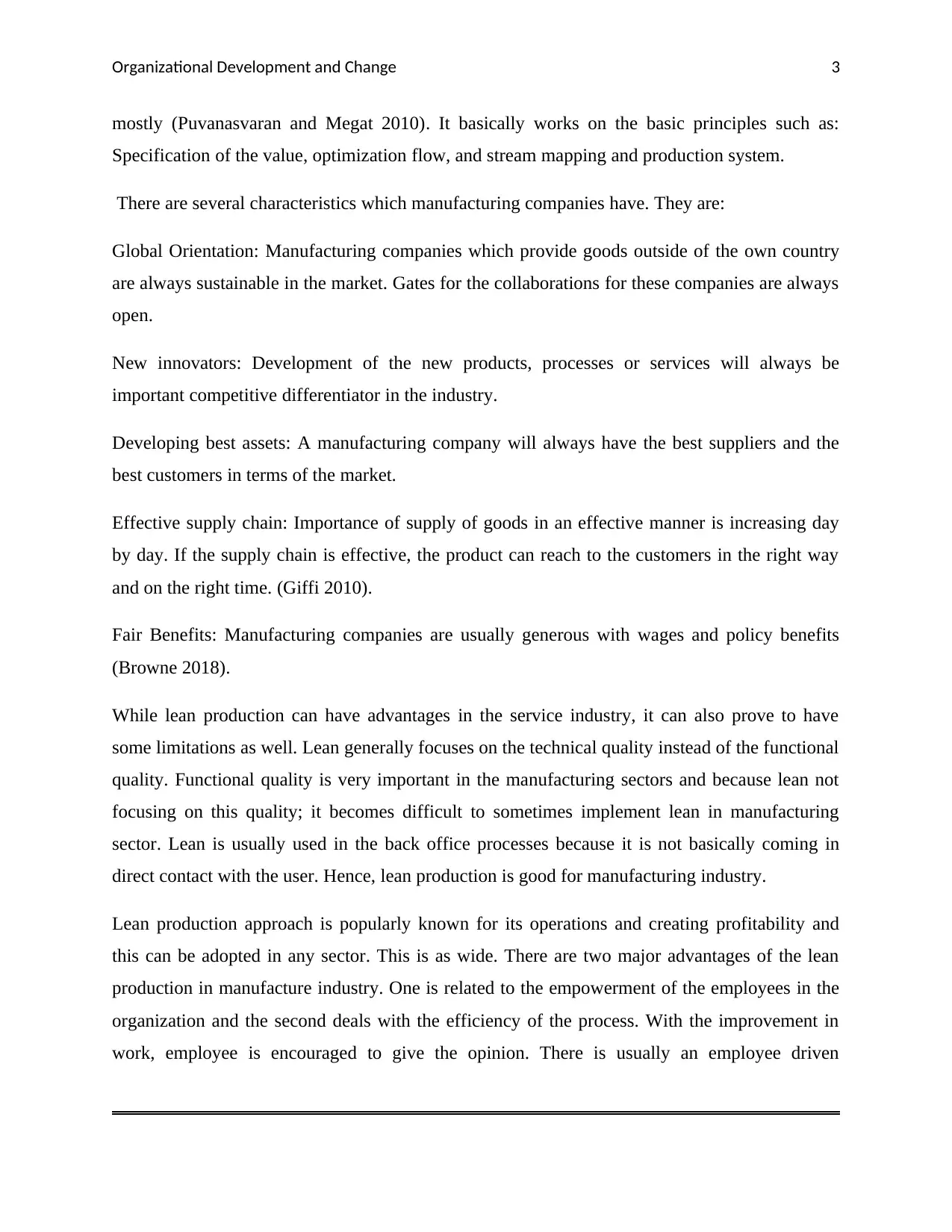
Organizational Development and Change
mostly (Puvanasvaran and Megat 2010). It basically works on the basic principles such as:
Specification of the value, optimization flow, and stream mapping and production system.
There are several characteristics which manufacturing companies have. They are:
Global Orientation: Manufacturing companies which provide goods outside of the own country
are always sustainable in the market. Gates for the collaborations for these companies are always
open.
New innovators: Development of the new products, processes or services will always be
important competitive differentiator in the industry.
Developing best assets: A manufacturing company will always have the best suppliers and the
best customers in terms of the market.
Effective supply chain: Importance of supply of goods in an effective manner is increasing day
by day. If the supply chain is effective, the product can reach to the customers in the right way
and on the right time. (Giffi 2010).
Fair Benefits: Manufacturing companies are usually generous with wages and policy benefits
(Browne 2018).
While lean production can have advantages in the service industry, it can also prove to have
some limitations as well. Lean generally focuses on the technical quality instead of the functional
quality. Functional quality is very important in the manufacturing sectors and because lean not
focusing on this quality; it becomes difficult to sometimes implement lean in manufacturing
sector. Lean is usually used in the back office processes because it is not basically coming in
direct contact with the user. Hence, lean production is good for manufacturing industry.
Lean production approach is popularly known for its operations and creating profitability and
this can be adopted in any sector. This is as wide. There are two major advantages of the lean
production in manufacture industry. One is related to the empowerment of the employees in the
organization and the second deals with the efficiency of the process. With the improvement in
work, employee is encouraged to give the opinion. There is usually an employee driven
3
mostly (Puvanasvaran and Megat 2010). It basically works on the basic principles such as:
Specification of the value, optimization flow, and stream mapping and production system.
There are several characteristics which manufacturing companies have. They are:
Global Orientation: Manufacturing companies which provide goods outside of the own country
are always sustainable in the market. Gates for the collaborations for these companies are always
open.
New innovators: Development of the new products, processes or services will always be
important competitive differentiator in the industry.
Developing best assets: A manufacturing company will always have the best suppliers and the
best customers in terms of the market.
Effective supply chain: Importance of supply of goods in an effective manner is increasing day
by day. If the supply chain is effective, the product can reach to the customers in the right way
and on the right time. (Giffi 2010).
Fair Benefits: Manufacturing companies are usually generous with wages and policy benefits
(Browne 2018).
While lean production can have advantages in the service industry, it can also prove to have
some limitations as well. Lean generally focuses on the technical quality instead of the functional
quality. Functional quality is very important in the manufacturing sectors and because lean not
focusing on this quality; it becomes difficult to sometimes implement lean in manufacturing
sector. Lean is usually used in the back office processes because it is not basically coming in
direct contact with the user. Hence, lean production is good for manufacturing industry.
Lean production approach is popularly known for its operations and creating profitability and
this can be adopted in any sector. This is as wide. There are two major advantages of the lean
production in manufacture industry. One is related to the empowerment of the employees in the
organization and the second deals with the efficiency of the process. With the improvement in
work, employee is encouraged to give the opinion. There is usually an employee driven
3
Paraphrase This Document
Need a fresh take? Get an instant paraphrase of this document with our AI Paraphraser

Organizational Development and Change
improvement work done if lean production is implemented in manufacturing sector. And with
the improvement in work, the efficiency of the processes that an organization is consisting of
becomes more efficient (Drotz 2014).
There are some change principles on which lean production works. Lean production focuses on
the process and the process is used to lower the abstraction level. Lean actually does not stress
the management with facts explicitly. The aspects of learning are also not very much emphasized
in lean production (Pettersen 2009). There is generally a misconception that the lean production
is used in only manufacturing industry but now days it is widely used in the service sector as
well. It is not just limited to the tools but it is also proven to be beneficial for finance results and
customer satisfactions. This practice needs the heart for reengineering and motivation for
organization to use it to the fullest for obtaining well returns economically and satisfactorily
(Vignesh, Suresh and Aramvarlthan 2008).
Service Industry
Socio Technical Systems are focused on creating the effective blending of technical and social
systems of the organization. This system is more appreciated by the users as it provides better
value to all the stakeholders (Gorejena and Mavetera 2016). It works with the help of the STE
(Socio – technical systems engineering) which is built on the independent research of the
investing groups such as IT, cognitive systems and cooperative work etc (Baxter and Somerville
2011).
There are several characteristics which service companies have. They are:
Intangibility: Services are mostly intangible. Unless the user or the consumer uses the service, it
will not be felt by the consumer. Usually consumer can end up feeling like they are not correctly
knowledgeable before purchasing any service.
4
improvement work done if lean production is implemented in manufacturing sector. And with
the improvement in work, the efficiency of the processes that an organization is consisting of
becomes more efficient (Drotz 2014).
There are some change principles on which lean production works. Lean production focuses on
the process and the process is used to lower the abstraction level. Lean actually does not stress
the management with facts explicitly. The aspects of learning are also not very much emphasized
in lean production (Pettersen 2009). There is generally a misconception that the lean production
is used in only manufacturing industry but now days it is widely used in the service sector as
well. It is not just limited to the tools but it is also proven to be beneficial for finance results and
customer satisfactions. This practice needs the heart for reengineering and motivation for
organization to use it to the fullest for obtaining well returns economically and satisfactorily
(Vignesh, Suresh and Aramvarlthan 2008).
Service Industry
Socio Technical Systems are focused on creating the effective blending of technical and social
systems of the organization. This system is more appreciated by the users as it provides better
value to all the stakeholders (Gorejena and Mavetera 2016). It works with the help of the STE
(Socio – technical systems engineering) which is built on the independent research of the
investing groups such as IT, cognitive systems and cooperative work etc (Baxter and Somerville
2011).
There are several characteristics which service companies have. They are:
Intangibility: Services are mostly intangible. Unless the user or the consumer uses the service, it
will not be felt by the consumer. Usually consumer can end up feeling like they are not correctly
knowledgeable before purchasing any service.
4
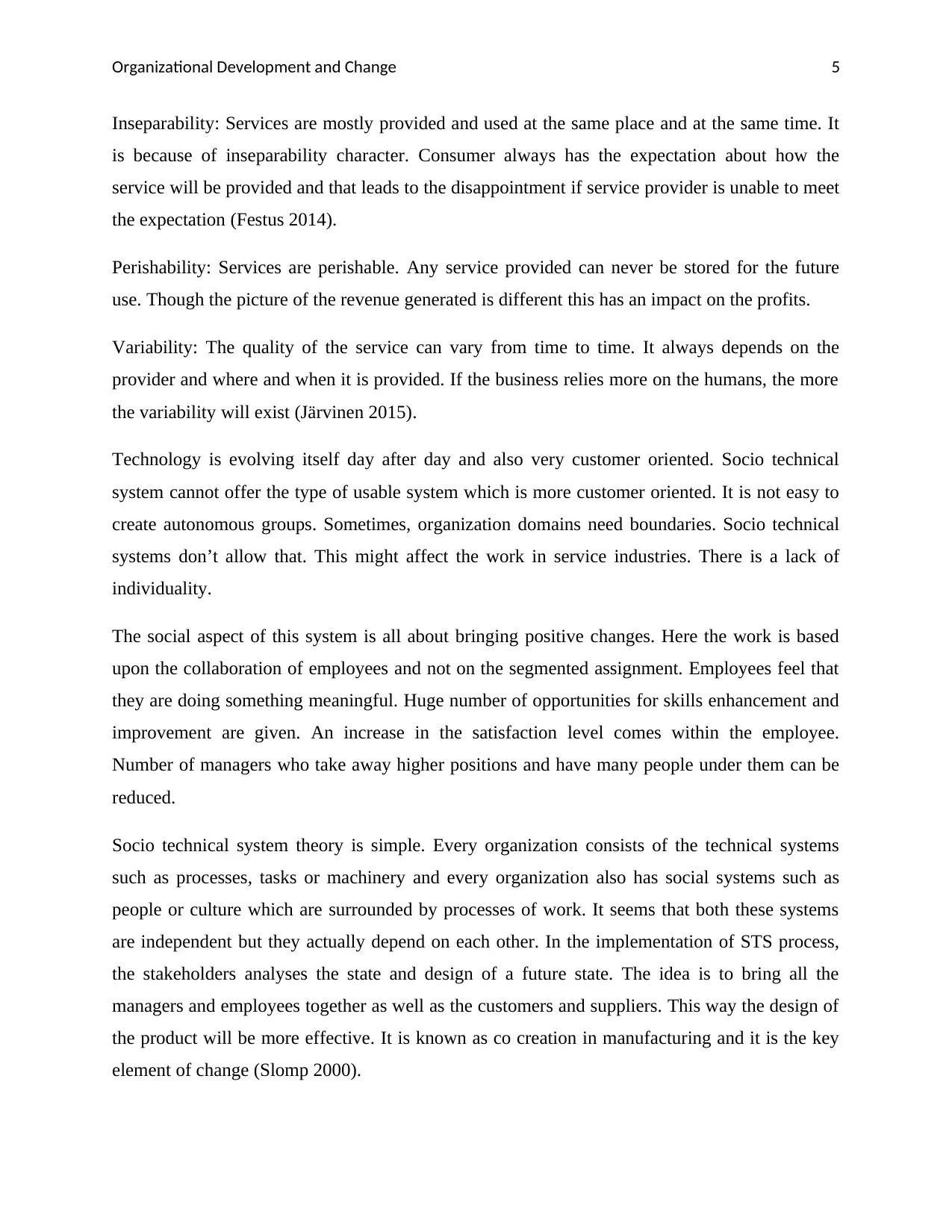
Organizational Development and Change
Inseparability: Services are mostly provided and used at the same place and at the same time. It
is because of inseparability character. Consumer always has the expectation about how the
service will be provided and that leads to the disappointment if service provider is unable to meet
the expectation (Festus 2014).
Perishability: Services are perishable. Any service provided can never be stored for the future
use. Though the picture of the revenue generated is different this has an impact on the profits.
Variability: The quality of the service can vary from time to time. It always depends on the
provider and where and when it is provided. If the business relies more on the humans, the more
the variability will exist (Järvinen 2015).
Technology is evolving itself day after day and also very customer oriented. Socio technical
system cannot offer the type of usable system which is more customer oriented. It is not easy to
create autonomous groups. Sometimes, organization domains need boundaries. Socio technical
systems don’t allow that. This might affect the work in service industries. There is a lack of
individuality.
The social aspect of this system is all about bringing positive changes. Here the work is based
upon the collaboration of employees and not on the segmented assignment. Employees feel that
they are doing something meaningful. Huge number of opportunities for skills enhancement and
improvement are given. An increase in the satisfaction level comes within the employee.
Number of managers who take away higher positions and have many people under them can be
reduced.
Socio technical system theory is simple. Every organization consists of the technical systems
such as processes, tasks or machinery and every organization also has social systems such as
people or culture which are surrounded by processes of work. It seems that both these systems
are independent but they actually depend on each other. In the implementation of STS process,
the stakeholders analyses the state and design of a future state. The idea is to bring all the
managers and employees together as well as the customers and suppliers. This way the design of
the product will be more effective. It is known as co creation in manufacturing and it is the key
element of change (Slomp 2000).
5
Inseparability: Services are mostly provided and used at the same place and at the same time. It
is because of inseparability character. Consumer always has the expectation about how the
service will be provided and that leads to the disappointment if service provider is unable to meet
the expectation (Festus 2014).
Perishability: Services are perishable. Any service provided can never be stored for the future
use. Though the picture of the revenue generated is different this has an impact on the profits.
Variability: The quality of the service can vary from time to time. It always depends on the
provider and where and when it is provided. If the business relies more on the humans, the more
the variability will exist (Järvinen 2015).
Technology is evolving itself day after day and also very customer oriented. Socio technical
system cannot offer the type of usable system which is more customer oriented. It is not easy to
create autonomous groups. Sometimes, organization domains need boundaries. Socio technical
systems don’t allow that. This might affect the work in service industries. There is a lack of
individuality.
The social aspect of this system is all about bringing positive changes. Here the work is based
upon the collaboration of employees and not on the segmented assignment. Employees feel that
they are doing something meaningful. Huge number of opportunities for skills enhancement and
improvement are given. An increase in the satisfaction level comes within the employee.
Number of managers who take away higher positions and have many people under them can be
reduced.
Socio technical system theory is simple. Every organization consists of the technical systems
such as processes, tasks or machinery and every organization also has social systems such as
people or culture which are surrounded by processes of work. It seems that both these systems
are independent but they actually depend on each other. In the implementation of STS process,
the stakeholders analyses the state and design of a future state. The idea is to bring all the
managers and employees together as well as the customers and suppliers. This way the design of
the product will be more effective. It is known as co creation in manufacturing and it is the key
element of change (Slomp 2000).
5
⊘ This is a preview!⊘
Do you want full access?
Subscribe today to unlock all pages.

Trusted by 1+ million students worldwide
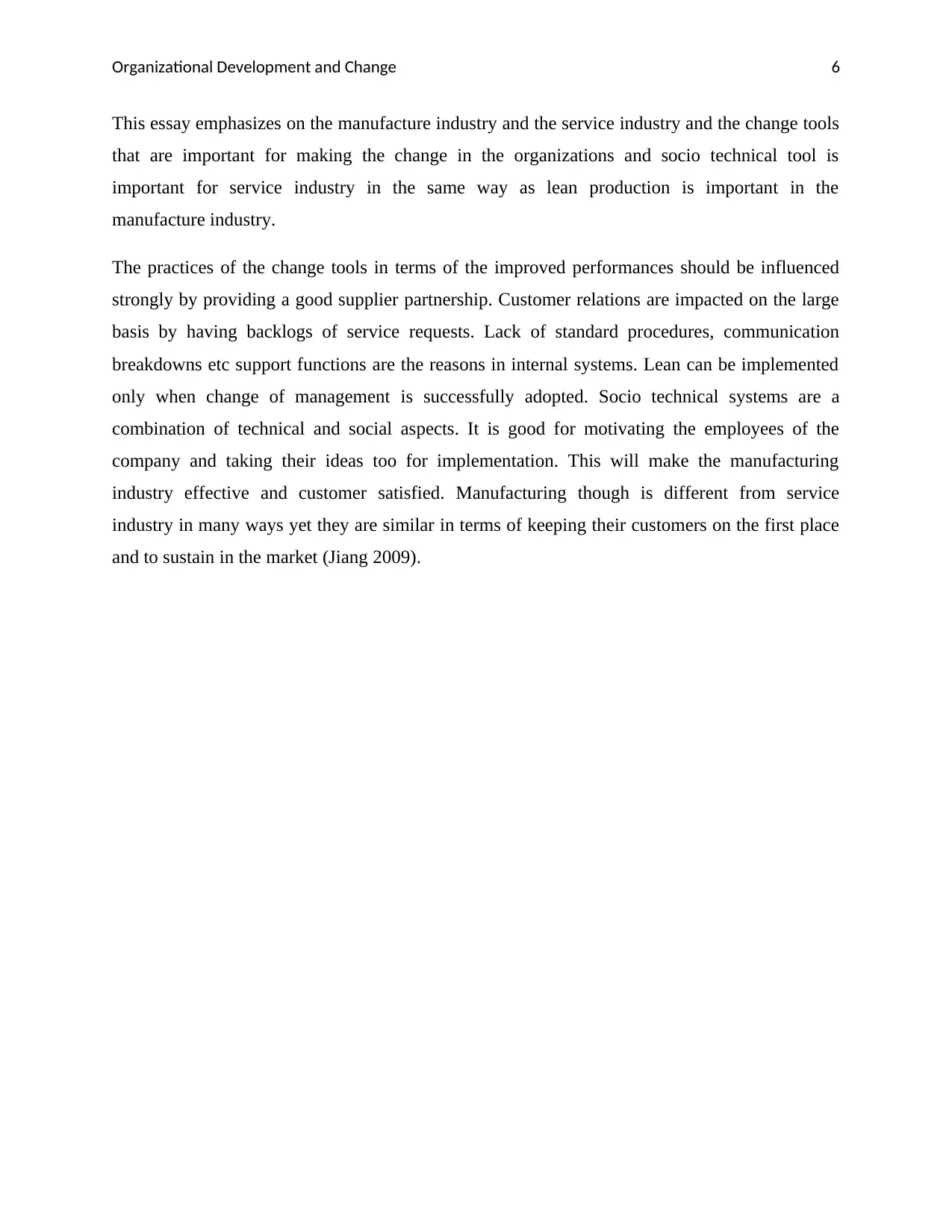
Organizational Development and Change
This essay emphasizes on the manufacture industry and the service industry and the change tools
that are important for making the change in the organizations and socio technical tool is
important for service industry in the same way as lean production is important in the
manufacture industry.
The practices of the change tools in terms of the improved performances should be influenced
strongly by providing a good supplier partnership. Customer relations are impacted on the large
basis by having backlogs of service requests. Lack of standard procedures, communication
breakdowns etc support functions are the reasons in internal systems. Lean can be implemented
only when change of management is successfully adopted. Socio technical systems are a
combination of technical and social aspects. It is good for motivating the employees of the
company and taking their ideas too for implementation. This will make the manufacturing
industry effective and customer satisfied. Manufacturing though is different from service
industry in many ways yet they are similar in terms of keeping their customers on the first place
and to sustain in the market (Jiang 2009).
6
This essay emphasizes on the manufacture industry and the service industry and the change tools
that are important for making the change in the organizations and socio technical tool is
important for service industry in the same way as lean production is important in the
manufacture industry.
The practices of the change tools in terms of the improved performances should be influenced
strongly by providing a good supplier partnership. Customer relations are impacted on the large
basis by having backlogs of service requests. Lack of standard procedures, communication
breakdowns etc support functions are the reasons in internal systems. Lean can be implemented
only when change of management is successfully adopted. Socio technical systems are a
combination of technical and social aspects. It is good for motivating the employees of the
company and taking their ideas too for implementation. This will make the manufacturing
industry effective and customer satisfied. Manufacturing though is different from service
industry in many ways yet they are similar in terms of keeping their customers on the first place
and to sustain in the market (Jiang 2009).
6
Paraphrase This Document
Need a fresh take? Get an instant paraphrase of this document with our AI Paraphraser

Organizational Development and Change
References
Baxter, Gordan, and Ian Somerville. "Socio-technical systems: From design methods to systems
engineering." Interacting with Computers 23, no. 1 (2011).
Browne, Clayton. smallbusiness.chron.com. 2018. http://smallbusiness.chron.com/top-five-
attributes-successful-manufacturing-companies-17749.html (accessed February 10, 2018).
Drotz, Erik. "pdfs.semanticscholar." pdfs.semanticscholar.org. 2014.
https://pdfs.semanticscholar.org/1091/de7b2b775a7338e8441aa49838d57b4768ad.pdf (accessed
February 10, 2018).
Festus, Nasobiari. "An Appraisal of Strategies and Challenges of Services." International
Journal of Managerial Studies and Research 2, no. 9 (2014).
Giffi, Craig. "Industryweek." Industryweek.com. 2010. http://www.industryweek.com/global-
economy/consistent-characteristics-competitive-manufacturers (accessed February 10, 2018).
Gorejena, Karikoka, and Nehemiah Mavetera. "“A critique and potency of socio-technical
systems theory: a quest for." Public and Municipal Finance 5, no. 2 (2016).
Järvinen, Uolevi Lehtinen and Raija. "The Role of Service." NJB 64, no. 3 (2015).
Jiang, Xin. "The Relationship between Manufacturing." International Journal of Business and
Management 4, no. 3 (2009).
Kocic, Alex. bizfluent. September 26, 2017. https://bizfluent.com/facts-6853113-definition-
manufacturing-industry.html (accessed February 10, 2018).
Kumar, Rakesh, and Vikas Kumar. "ymcaust.ac." ymcaust.ac.in. October 2012.
http://ymcaust.ac.in/tame2012/cd/industrial/IE-12.pdf (accessed February 10, 2018).
Lingham, Tony, Bonnie Richley, and Cefery Soler. "proxymy.esade." proxymy.esade.edu. April
2005.
http://proxymy.esade.edu/gd/facultybio/publicos/1311348478279Experiencing_organizational_c
7
References
Baxter, Gordan, and Ian Somerville. "Socio-technical systems: From design methods to systems
engineering." Interacting with Computers 23, no. 1 (2011).
Browne, Clayton. smallbusiness.chron.com. 2018. http://smallbusiness.chron.com/top-five-
attributes-successful-manufacturing-companies-17749.html (accessed February 10, 2018).
Drotz, Erik. "pdfs.semanticscholar." pdfs.semanticscholar.org. 2014.
https://pdfs.semanticscholar.org/1091/de7b2b775a7338e8441aa49838d57b4768ad.pdf (accessed
February 10, 2018).
Festus, Nasobiari. "An Appraisal of Strategies and Challenges of Services." International
Journal of Managerial Studies and Research 2, no. 9 (2014).
Giffi, Craig. "Industryweek." Industryweek.com. 2010. http://www.industryweek.com/global-
economy/consistent-characteristics-competitive-manufacturers (accessed February 10, 2018).
Gorejena, Karikoka, and Nehemiah Mavetera. "“A critique and potency of socio-technical
systems theory: a quest for." Public and Municipal Finance 5, no. 2 (2016).
Järvinen, Uolevi Lehtinen and Raija. "The Role of Service." NJB 64, no. 3 (2015).
Jiang, Xin. "The Relationship between Manufacturing." International Journal of Business and
Management 4, no. 3 (2009).
Kocic, Alex. bizfluent. September 26, 2017. https://bizfluent.com/facts-6853113-definition-
manufacturing-industry.html (accessed February 10, 2018).
Kumar, Rakesh, and Vikas Kumar. "ymcaust.ac." ymcaust.ac.in. October 2012.
http://ymcaust.ac.in/tame2012/cd/industrial/IE-12.pdf (accessed February 10, 2018).
Lingham, Tony, Bonnie Richley, and Cefery Soler. "proxymy.esade." proxymy.esade.edu. April
2005.
http://proxymy.esade.edu/gd/facultybio/publicos/1311348478279Experiencing_organizational_c
7
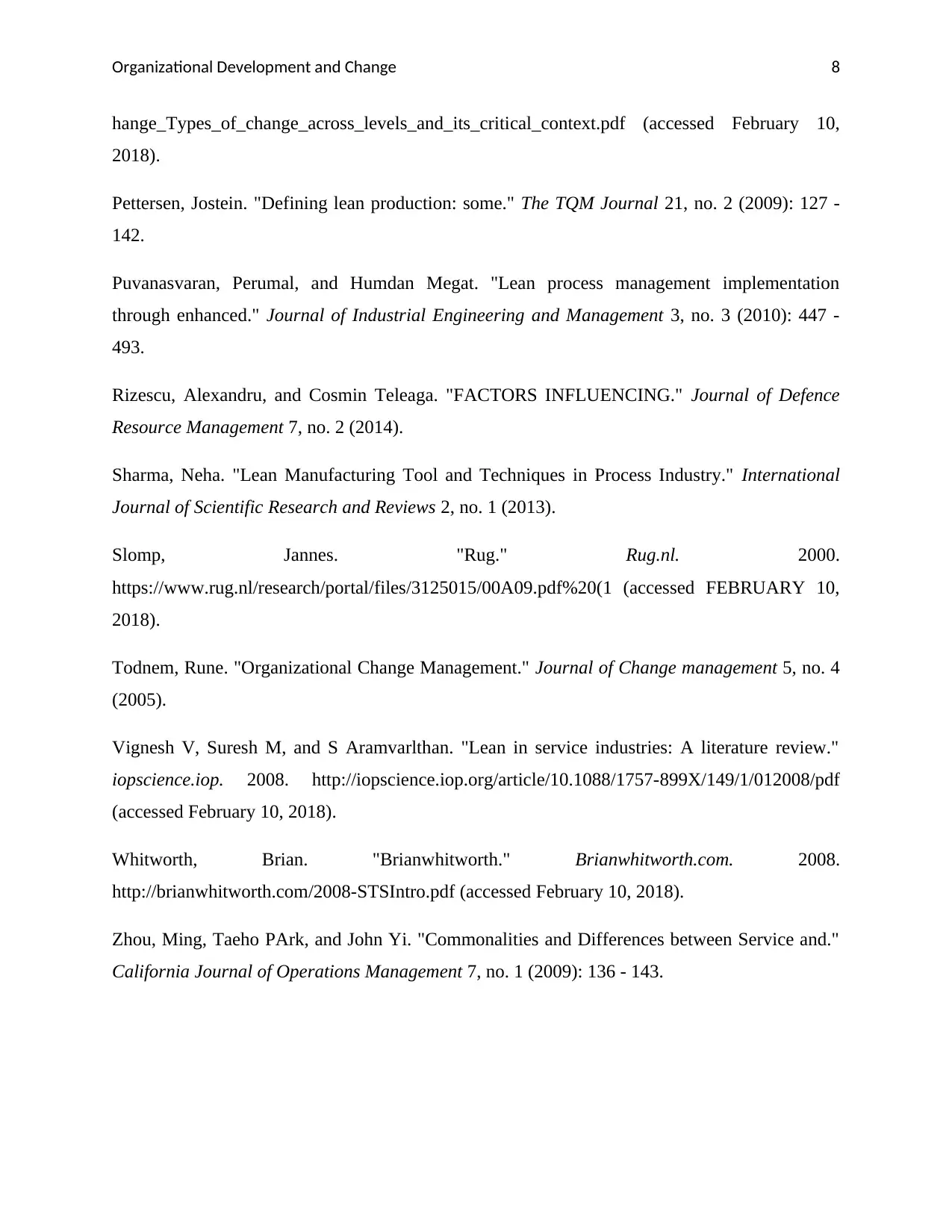
Organizational Development and Change
hange_Types_of_change_across_levels_and_its_critical_context.pdf (accessed February 10,
2018).
Pettersen, Jostein. "Defining lean production: some." The TQM Journal 21, no. 2 (2009): 127 -
142.
Puvanasvaran, Perumal, and Humdan Megat. "Lean process management implementation
through enhanced." Journal of Industrial Engineering and Management 3, no. 3 (2010): 447 -
493.
Rizescu, Alexandru, and Cosmin Teleaga. "FACTORS INFLUENCING." Journal of Defence
Resource Management 7, no. 2 (2014).
Sharma, Neha. "Lean Manufacturing Tool and Techniques in Process Industry." International
Journal of Scientific Research and Reviews 2, no. 1 (2013).
Slomp, Jannes. "Rug." Rug.nl. 2000.
https://www.rug.nl/research/portal/files/3125015/00A09.pdf%20(1 (accessed FEBRUARY 10,
2018).
Todnem, Rune. "Organizational Change Management." Journal of Change management 5, no. 4
(2005).
Vignesh V, Suresh M, and S Aramvarlthan. "Lean in service industries: A literature review."
iopscience.iop. 2008. http://iopscience.iop.org/article/10.1088/1757-899X/149/1/012008/pdf
(accessed February 10, 2018).
Whitworth, Brian. "Brianwhitworth." Brianwhitworth.com. 2008.
http://brianwhitworth.com/2008-STSIntro.pdf (accessed February 10, 2018).
Zhou, Ming, Taeho PArk, and John Yi. "Commonalities and Differences between Service and."
California Journal of Operations Management 7, no. 1 (2009): 136 - 143.
8
hange_Types_of_change_across_levels_and_its_critical_context.pdf (accessed February 10,
2018).
Pettersen, Jostein. "Defining lean production: some." The TQM Journal 21, no. 2 (2009): 127 -
142.
Puvanasvaran, Perumal, and Humdan Megat. "Lean process management implementation
through enhanced." Journal of Industrial Engineering and Management 3, no. 3 (2010): 447 -
493.
Rizescu, Alexandru, and Cosmin Teleaga. "FACTORS INFLUENCING." Journal of Defence
Resource Management 7, no. 2 (2014).
Sharma, Neha. "Lean Manufacturing Tool and Techniques in Process Industry." International
Journal of Scientific Research and Reviews 2, no. 1 (2013).
Slomp, Jannes. "Rug." Rug.nl. 2000.
https://www.rug.nl/research/portal/files/3125015/00A09.pdf%20(1 (accessed FEBRUARY 10,
2018).
Todnem, Rune. "Organizational Change Management." Journal of Change management 5, no. 4
(2005).
Vignesh V, Suresh M, and S Aramvarlthan. "Lean in service industries: A literature review."
iopscience.iop. 2008. http://iopscience.iop.org/article/10.1088/1757-899X/149/1/012008/pdf
(accessed February 10, 2018).
Whitworth, Brian. "Brianwhitworth." Brianwhitworth.com. 2008.
http://brianwhitworth.com/2008-STSIntro.pdf (accessed February 10, 2018).
Zhou, Ming, Taeho PArk, and John Yi. "Commonalities and Differences between Service and."
California Journal of Operations Management 7, no. 1 (2009): 136 - 143.
8
⊘ This is a preview!⊘
Do you want full access?
Subscribe today to unlock all pages.

Trusted by 1+ million students worldwide
1 out of 9
Related Documents
Your All-in-One AI-Powered Toolkit for Academic Success.
+13062052269
info@desklib.com
Available 24*7 on WhatsApp / Email
![[object Object]](/_next/static/media/star-bottom.7253800d.svg)
Unlock your academic potential
Copyright © 2020–2025 A2Z Services. All Rights Reserved. Developed and managed by ZUCOL.




